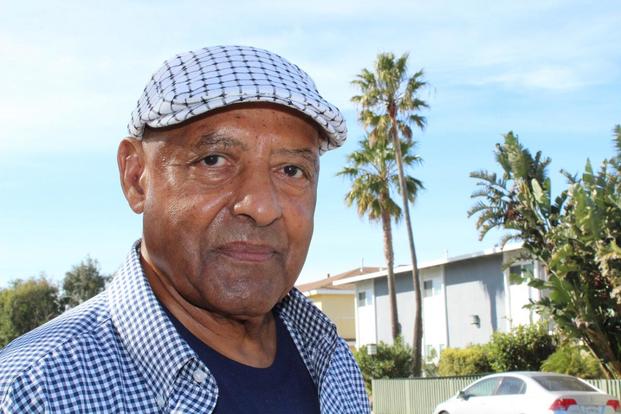Fifty years after Battle of Hue City, retired Marine John L. Canley has moved a step closer to receiving the Medal of Honor for his "above and beyond" actions in the house-to-house fighting.
On Monday night, President Donald Trump signed a bill passed by Congress to waive the five-year limit on recommendations for the nation's highest award for valor and authorized the upgrade of Canley's Navy Cross to the Medal of Honor.
The bill (H.R.4641), sponsored by Rep. Julia Brownley, D-California, "authorizes the President to award the Medal of Honor to Gunnery Sergeant John L. Canley for acts of valor during the Vietnam War while serving in the Marine Corps."
No date has been set for the formal award, but Canley has the backing of Defense Secretary Jim Mattis.
Related content:
- Marine Backed by Mattis for MoH to Attend State of the Union
- Ample Support for Gunny Canley's MoH in Bowden Book on Hue Battle
- Marine Gunny Gets Medal of Honor Nod for Battle of Hue Actions
In a letter to Brownley last month, Mattis said, "After giving careful consideration to the nomination, I agree that then-Gunnery Sergeant Canley's actions merit the award of the Medal of Honor."
The 80-year-old Canley, of Oxnard, California, who retired as a sergeant major after 28 years of service, will be Brownley's guest of honor Tuesday night at Trump's State of the Union address to a joint session of Congress.
Canley "is a true American hero and a shining example of the kind of gallantry and humility that makes our armed forces the best military in the world," Brownley said in a statement Monday night.
"It is my great honor that he will be attending the State of the Union with me tomorrow -- 50 years to the day of the start of the Tet Offensive, where his bravery and courage saved many lives," she said.
In a statement to Brownley after Trump signed the bill, Canley said, "This honor is for all of the Marines with whom I served. They are an inspiration to me to this day."
He earlier told Military.com that in the grueling 1968 fight to retake Hue from the North Vietnamese Army and the Viet-Cong: "The only thing I was doing was taking care of troops, best I could. Do that, and everything else takes care of itself."
Canley also thanked Brownley and a member of her staff, Laura Sether, "for their effort and work to make this happen."
They worked closely with the survivors from Alpha Co., 1st Battalion, 1st Marine Regiment, 1st Marine Division, who fought with Canley at Hue and mounted a 13-year effort to get past the red tape to upgrade his Navy Cross to the Medal of Honor.
John Ligato, a private first class in Alpha 1/1 and a retired FBI agent who was part of the effort to upgrade the medal, said of Canley: "This man is the epitome of a Marine warrior."
At Hue, Canley took command of Alpha 1/1 when Capt. Gordon Batcheller, the company commander, was wounded and evacuated.
He fought alongside Sgt. Alfredo Cantu "Freddy" Gonzalez, who had taken command of Third Platoon, Alpha 1/1, and was posthumously awarded the Medal of Honor.
Canley's Navy Cross cites his actions from Jan. 31 to Feb. 6, 1968, when he had command of Alpha 1/1 before being relieved by then-Lt. Ray Smith, a Marine legend who earned the Navy Cross, two Silver Stars, a Bronze Star and three Purple Hearts during his tours in Vietnam and retired as a major general.
"On 31 January, when his company came under a heavy volume of enemy fire near the city of Hue, Gunnery Sergeant Canley rushed across the fire-swept terrain and carried several wounded Marines to safety," the citation states.
Canley then "assumed command and immediately reorganized his scattered Marines, moving from one group to another to advise and encourage his men. Although sustaining shrapnel wounds during this period, he nonetheless established a base of fire which subsequently allowed the company to break through the enemy strongpoint," it continues.
On Feb. 4, "despite fierce enemy resistance," Canley managed to get into the top floor of a building held by the enemy. He then "dropped a large satchel charge into the position, personally accounting for numerous enemy killed, and forcing the others to vacate the building," the citation says.
The battle raged on. Canley went into action again on Feb. 6 as the company took more casualties in an assault on another enemy-held building.
"Gunnery Sergeant Canley lent words of encouragement to his men and exhorted them to greater efforts as they drove the enemy from its fortified emplacement," the citation states.
In speaking of Canley, Ligato, retired Maj. Gen. Smith, former Lance Cpl. Eddie Neas and others who served with him, both in battle and stateside, told of his indefinable command presence that made them want to follow and emulate his example.
"The most impressive combat Marine I ever knew," Smith told Military.com.
Smith recalled that at his own retirement ceremony at Camp Lejeune, North Carolina, he said, "All through my career, whenever I had to make a decision that would affect Marines, I'd always think -- 'What would Canley tell me to do?' "
Canley's command presence was such that others who served with him to this day recall him in awe as a 6-foot-4 or 6-foot-5 tower of strength who would calmly pick up wounded Marines, put them on his shoulder, and run through fire to safety.
"They worshipped the ground the guy walked on," Smith said of Canley, but "he was actually about six feet" tall.
-- Richard Sisk can be reached at Richard.Sisk@Military.com.












